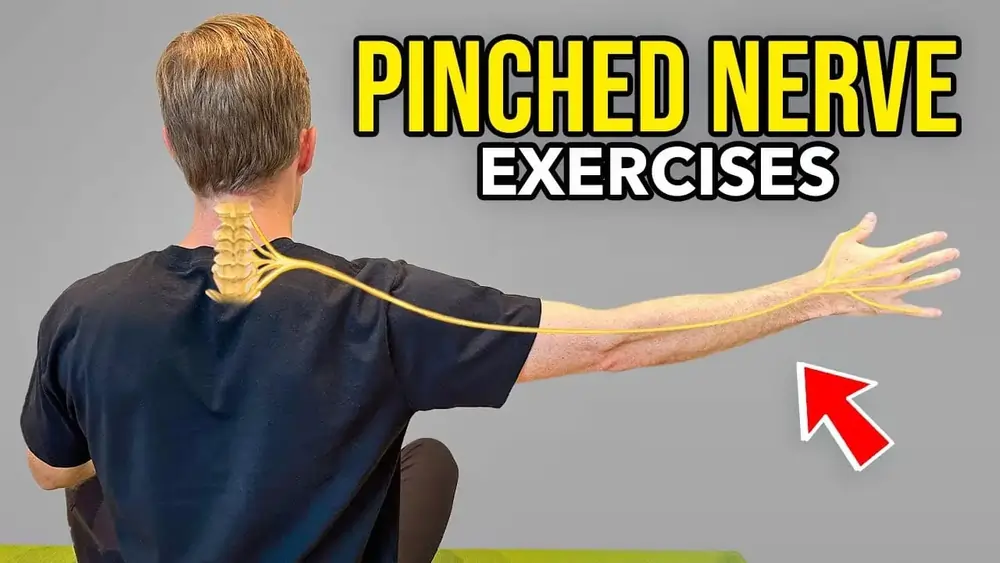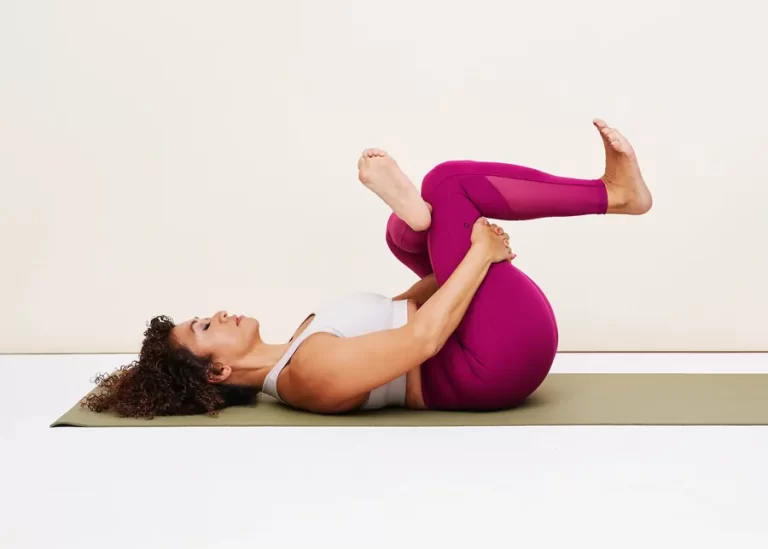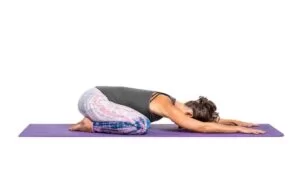13 Best Exercises for Pinched Nerves in the Neck
A pinched nerve in the neck (cervical radiculopathy) occurs when a nerve in the neck is compressed or irritated, mainly due to a slipped disc, bone spurs, or poor posture. Gentle neck exercises under the guidance of a Physical therapist can help relieve pressure on the nerve, improve mobility, and reduce pain and stiffness.
We’ll look at some of the top exercises in this article, intended to reduce compression on the neck nerves and increase strength and flexibility in the affected area. To be sure it’s safe and suitable for your particular condition, it’s important to speak with a healthcare provider before beginning any fitness program.
Introduction:
A nerve in the cervical spine may become irritated or compressed, resulting in cervical radiculopathy, another term for a pinched nerve in the neck. Herniated discs, arthritis, bad posture, or even tense muscles from stress can cause it. This condition often shows pain, tingling sensations, numbness, or fatigue that travels from the neck to the hand, arm, or shoulder.
It may be painful and uncomfortable to have pinched nerves in your neck. Certain mild neck exercises can help reduce pressure on the nerve, restore mobility, and promote long-term healing, even if rest and medical therapy are frequently advised.
When choosing the most effective exercises for pinched nerves in the neck, it’s important to concentrate on motions that promote correct positioning, lower stress levels, and increase range of motion. These workouts target the neck and related regions to improve functionality and lessen pain.
However, small soreness can be lessened with easy exercises. The primary purpose of these moves is to release pressure on the nerve and stretch the neck muscles. To prevent nerve damage, do these exercises gradually.
Causes:
Bulging or Herniated Disc
- Inflammation and nerve compression result from the disc material pressing against the surrounding nerve roots.
Degenerative Disc Disease
- As a result, the disc height decreases, causing foraminal constriction, which reduces the space available for nerves to leave.
Repeated Stress
- Causes inflammation or persistent muscular strain, which compresses nerves.
Being overweight
- Causes issues with posture and disc degeneration.
Inflammatory Conditions
- Inflammation can squeeze surrounding nerves and cause injury to joints or discs.
Cervical Spondylosis (Neck Arthritis)
- Pinched nerves may result from these alterations that constrict the spaces of the spinal canal or nerve roots.
Bad Posture
- Puts more strain on the cervical spine, which eventually causes imbalance and irritation of the nerves.
Spinal Stenosis
- Frequently gets worse with age and compresses the spinal cord or nerve roots.
Injury or Trauma
- May induce disc herniation, vertebral displacement, or inflammation of the tissues around the nerve.
Advantages of exercise:
Specific exercises might be very important for healing and pain management when a cervical spine nerve becomes compressed (cervical radiculopathy). When performed properly, these exercises can greatly speed up healing and prevent further issues.
Pain decrease
- The affected nerve is gradually decompressed via exercises.
- Stretching increases the distance between vertebrae and releases tense muscles.
Improved Flexibility and Mobility
- Stiff joints and tense muscles are released with stretches and careful motions.
- Eliminates the protective tightening cycle that restricts movement.
Increased Supporting Muscle Strength
- The deep neck flexors, trapezius, and shoulder stabilizers are the focus of strengthening workouts.
- Stronger muscles lessen strain on the nerve and maintain the correct position of the spine.
Avoiding Muscle Atrophy
- Nerve compression frequently results in weakness.
- Specific workouts maintain muscular activity and lower the chance of imbalance or atrophy.
Decreased Reliance on Medicine
- An all-natural, without medication method of managing pain and speeding up recovery is exercise.
- Lessens the need for painkillers, muscle relaxants, and anti-inflammatory medications.
Benefits to the Mind
- Gentle exercise improves mood and increases endorphins.
- Makes you feel more in charge of your health and more confident.
Decreased Surgery Risk
- Exercise and other conservative measures are frequently successful in relieving pinched nerves.
- If begun early, it could prevent the need for surgery or injections.
Better Everyday Performance
- Movement is restored, and symptoms are lessened with exercise.
- Facilitates the enjoyment of physical activities, driving, working, and sleeping.
An improvement in nerve function
- The squeezed nerve receives more oxygen and blood when it is moving.
- Helps the nerve “breathe” and heal while lowering inflammation.
Exercises for Pinched Nerves in the Neck:
Here are a few safe and efficient exercises for neck pain nerves.
Shoulder Rolls
- Stand up straight on the ground to begin.
- Make sure your feet are shoulder-width apart.
- Make sure your knees are slightly bent so they meet your toes, not beyond them.
- Keep your neck straight and your chin high, staring directly ahead.
- Raise your shoulders as near your ears as you can while taking a breath.
- Take your time with the workout to feel the resistance of your muscles.
- Then return to your neutral position.
- Then relax.
- Repeat these exercises 5 to 10 times.
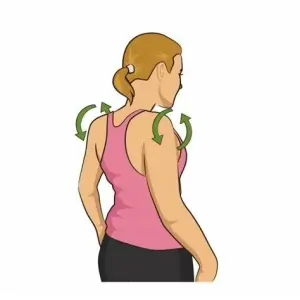
Neck Turn
- Start by sitting in a chair.
- Head tilt to one side to create a feeling that you are looking over your shoulder.
- Hold your chin up.
- Your neck muscles should be gently tight.
- Hold this position for a few seconds.
- Then return to your neutral position.
- Then relax.
- Repeat these exercises 5 to 10 times.
- Repeat the exercises on the opposite side.
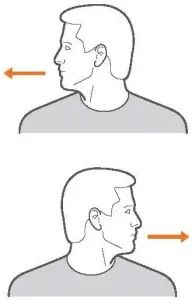
Isometric Neck Exercise
- Start by selecting a comfortable place to sit.
- Put a hand over your forehead.
- Your neck muscles will have to tighten to keep up with the pull.
- Hold this pose for a few seconds.
- Next, the left side of the head needs to be pressed.
- Hold this pose for a few seconds.
- Now switch sides.
- Following that, put pressure on the right side of your head.
- Hold this pose for a few seconds.
- Next, put pressure on your skull’s back.
- Hold this position for a few seconds.
- Then return to your neutral position.
- Then relax.
- Repeat these exercises 5 to 10 times.
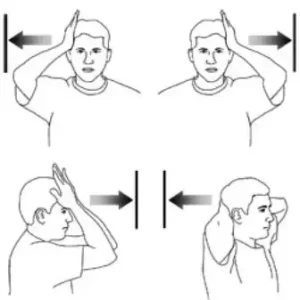
Chin Tuck
- Looking forward, sit or stand up straight.
- Roll your head back while keeping your level of concentration.
- Pull your chin into your throat while maintaining your head down.
- Hold this position for a few seconds.
- Then return to your neutral position.
- Then relax.
- Repeat these exercises 5 to 10 times.
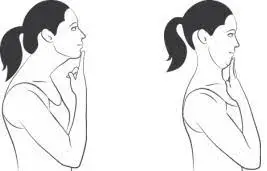
Side-to-side head tilt stretches
- Start with a standing position.
- Starting at the ear, slowly turn the neck in the direction of the shoulder.
- Make a small stretch using your neck muscles.
- Hold this position for a few seconds.
- Then return to your neutral position.
- Then relax.
- Repeat these exercises 5 to 10 times.
- Continue with the same exercise on the other side.
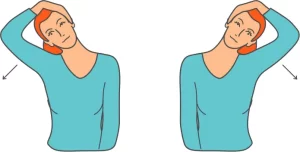
Shoulder Shrugs
- Start with a relaxing standing position.
- Ensure that your hands remain by your sides.
- Breathe deeply, then raise your shoulders to your ears.
- Proceed slowly in this manner.
- Hold this position for a few seconds.
- Lower your shoulders and exhale deeply.
- Then return to your neutral position.
- Then relax.
- Repeat these exercises 5 to 10 times.
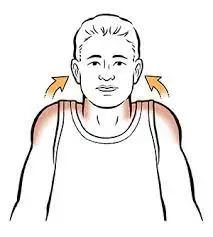
Shoulder Blade Squeeze
- To begin, stand up and place your feet level on the ground.
- Then, elevate your arms to shoulder height while keeping your elbows flexed.
- Next, squeeze your shoulder blades together.
- Hold this position for a few seconds.
- Then return to your neutral position.
- Then relax.
- Repeat these exercises 5 to 10 times.
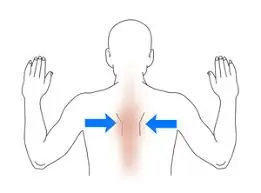
Standing band row
- Put a band around a solid object in front of you, such as a door anchor or squat rack.
- Using both hands, grasp the band’s ends and make a row.
- Concentrate on pulling the shoulder blades back.
- Thereafter, draw the band toward your abdomen.
- Hold this position for a few seconds.
- Then return to your neutral position.
- Then relax.
- Repeat these exercises 5 to 10 times.
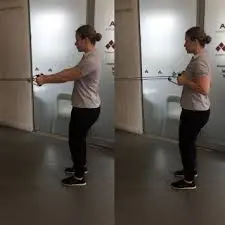
Side bends
- Put your feet together and stand tall.
- Then extend both arms straight up above while you take a breath.
- Put your right arm down on your right side.
- Next, lower your left arm above your head, take a breath, and slowly bend your body to the right.
- Hold this position for a few seconds.
- Then return to your neutral position.
- Then relax.
- Repeat these exercises 5 to 10 times.
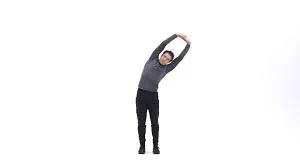
Neck roll
- Stand up on the floor to begin.
- Start with your head turned to the right side.
- You should feel as though your trapezius muscle is extending your neck.
- Carefully turn your head in the opposite direction after a few seconds.
- As you reach your left shoulder, hold this position for a few seconds.
- Once more, turn in a clockwise direction.
- Then return to your neutral position.
- Then relax.
- Repeat these exercises 5 to 10 times.
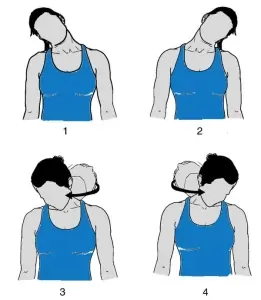
Upper Trapezius Stretch
- First, settle into a comfortable sitting position.
- Raise your chin a little.
- Afterward, grab the right side of your head with your left hand….
- Gently turn your head to the left.
- Hold this position for a few seconds.
- Lightly press to increase the stretch.
- Then return to your neutral position.
- Then relax.
- Repeat these exercises 5 to 10 times.
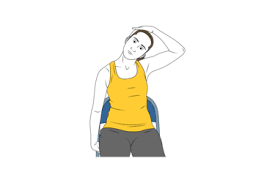
Reverse shoulder stretch
- Begin by standing on the floor.
- Maintain your arms at your sides.
- With your thumbs toward the floor, put your hands behind your back.
- Hold your hands back and to the ceiling while standing upright and opening your chest.
- When your biceps and shoulders start to expand, stop.
- Hold this position for a few seconds.
- Then return to your neutral position.
- Then relax.
- Repeat these exercises 5 to 10 times.
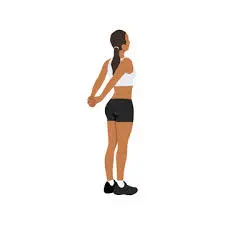
Thoracic extension
- Take a seat on the chair to get started.
- Your shoulders should remain down and back.
- Put your hands behind your head now.
- As you raise your upper back above the chair, maintain a straight stance.
- Hold this position for a few seconds.
- Then return to your neutral position.
- Then relax.
- Repeat these exercises 5 to 10 times.
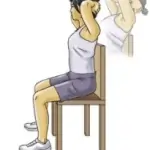
Levator scapulae stretch
- Sitting upright in the chair.
- To pull the shoulder down, grab the bottom of the seat with your hand on the side that is affected.
- You shift your head to the opposite side.
- If necessary, extend the stretch by gently applying more pressure with your hand.
- Hold this position for a few seconds.
- Then return to your neutral position.
- Then relax.
- Repeat these exercises 5 to 10 times.
- Repeat on the opposite side.
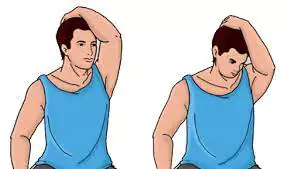
What precautions should be taken when exercising?
A pinched nerve can be effectively managed with exercise, however improper kind of exercise might make the issue worse. Reducing nerve compression, easing pain, and eventually regaining function are the goals.
Before working out, warm up.
- Stiff joints and cold muscles are more likely to get injured and spasm, making the pinched nerve worse.
- Engage in deep breathing, arm swings, or gentle shoulder rolls.
- When stretching, stay away from chilly areas.
First, get a medical evaluation.
- It’s critical to determine whether a herniated disc, arthritis, stenosis, or trauma is the reason for the pinched nerve.
- The therapy and exercise regimens alter as a result.
Don’t Do Any Exercise That Makes You Feel Worse
- Exercise-related or post-exercise pain might be a sign that you’re aggravating inflammatory tissues or further squeezing the nerve.
- Any exercise that causes these symptoms should be stopped right away.
- Experiencing pain does not indicate improvement.
Start with Easy, Low-Intensity Exercises
- The condition of your neck is serious.
- Intense or dynamic motions at first might put tension on the neck muscles and worsen compression.
Make sure you maintain proper posture.
- Bad form, particularly forward head position, worsens nerve compression and puts additional mechanical strain on the neck.
Stay away from high-resistance or overhead movements.
- Avoid movements with high resistance or overhead.
- Using big weights or carrying objects above can put downward strain on the spine and promote compression of the nerve roots.
- See a therapist if strength training is required, and use neck-stabilizing equipment.
Reduce Your Speed and Take Regular Breaks
- Overdoing a stretch or rushing through repetitions might cause problems.
- Take a break in between reps and hold each stretch lightly.
- Workouts should be done slowly and intentionally since speed increases risk.
- Start by keeping the overall amount of time spent exercising to 15 to 30 minutes per session.
Avoid dehydration and control inflammation.
- Hydration promotes the health of the discs, while inflammation exacerbates nerve compression.
- Before and after working out, drink water.
- If you have pain after stretching, use ice.
Don’t force or extend too far your range of motion.
- Excessive stretching can cause the nerve root to become compressed or irritated, which increases inflammation.
- For 15 to 30 seconds, hold light stretches.
- Avoid violently bouncing or pulling your head.
- If the sensation gets worse, stop right away.
Change Your Sleep and Posture Patterns Every Day
- Daily posture practices have an equal impact on nerve healing or aggravation as exercise.
- Make sure your workstations are comfortable (screen at eye level, back supported).
- If you are sedentary, take short walks or stand every 30 to 60 minutes.
Commit to a progression plan.
- Phases of recovery from a pinched nerve include symptom reduction, mobility restoration, and strengthening.
When did you stop exercising?
When you have cervical radiculopathy, or a pinched nerve, exercise can be a component of a successful healing strategy. However, in certain cases, continuing to exercise can make your condition worse. Knowing when to stop or slow down is essential for both safety and recovery.
If Your Pain Is Increasing or Radiating
- Increased pain during or after activity, particularly if it radiates into your fingers, arm, or shoulder, might be an indication of worsening nerve compression.
- Stop the workout right away.
If You Experience Lightheadedness, Dizziness, or Unstable
- Exercises for the neck, particularly those that include flexion or rotation, might alter neural pathways related to balance or compress blood vessels.
- Put an end to your workout and find a secure spot to sit.
- Rest and drink plenty of water.
If You Experience Changes in Your Vision or Severe Headaches
- Referred pain, headaches, or vision problems can occasionally result from neck instability or nerve compression that affects surrounding nerves or blood flow to the head.
- Stop any neck movements right away.
- Lie down in a dark place or apply cold compresses.
If You Can’t Control Your Bowels or Bladder
- This could indicate spinal cord compression, an uncommon but potentially fatal condition called cervical myelopathy or lower back cauda equina syndrome.
- This issue frequently needs surgery right away.
If, rather than getting better, symptoms get worse over the days
- Symptoms should be progressively relieved by exercise.
- You can aggravate the nerve even more if you’re following the right regimen and your symptoms keep getting worse over a few days.
- Put your routine on hold.
If You’re Feeling Too Tired or Confused
- Fatigue and trouble focusing can result from nerve dysfunction and chronic pain.
- Excessive exercise might worsen these systemic problems.
- Make rest and recuperation a priority.
If tingling or numbness worsens
- A worsening or spreading numbness or tingling indicates that the nerve is still inflamed or increasingly squeezed.
- Put an end to the activity causing the symptoms.
- Keep a record of your symptoms, noting their severity and the places where they are happening.
If You Feel Weak in Your Muscles
- Weakness, including trouble grasping, raising the arm, or holding items, may be a sign of developing motor nerve injury.
When to Consult a Physician:
Consult a medical professional if:
- After a few days of activity, the pain continues or becomes worse.
- You suffer from severe weakness or numbness.
- Loss of control over the bowels or bladder (get emergency care)
Summary:
The neck, shoulders, hands, or arms of a person with a pinched nerve may tingle, go numb, or become weak. Pinched nerves are common as people age, develop arthritis, or endure wear and tear on their spines.
Even though a pinched nerve in the neck can be extremely painful and frustrating, several stretching and strengthening techniques can significantly reduce symptoms and speed up the healing process. Always proceed cautiously when exercising, and see a doctor to be sure you’re performing the proper movements for your particular condition.
A customized physical therapy program can provide significant improvements in strength and mobility, as well as immediate benefits for a lot of people. However, if pain does not go away with time, doctors could suggest alternative treatments.
FAQ:
Does exercising help a pinched nerve?
By strengthening and stretching the right muscles, you may improve your posture to help relieve pain, move more fluidly, and provide more space for an inflammation nerve to migrate.
How long does a pinched nerve last?
After 6 to 12 weeks of prevention treatment, nerve function usually recovers to normal, and symptoms often disappear. Conservative therapies include non-steroidal anti-inflammatory medicines (NSAIDs), such as ibuprofen, and physical therapy.
How much may a pinched nerve be relieved by stretching?
Sometimes, simple stretches can relieve pain instantly. Back pain and pinched nerves are most relieved by the child’s posture stretch, which is simple to do.
How can I protect my neck when exercising?
By maintaining a neutral spine and using the right muscles during a specific exercise, like lifting weights, neck injuries can be prevented. If you have any neck pain, pause and modify your technique.
How can one prevent pinched nerves?
Make strength and flexibility training a part of your regular workout routine.
Reduce the number of routine tasks you perform and take frequent breaks.
Maintain a healthy weight.
What causes a pinching sensation in the neck?
Herniated or bulging cervical discs
Degenerative disc disease
Poor posture
Bone spurs (from arthritis)
For what length of time should I perform these exercises before seeing relief?
Many people report feeling better after just one to two weeks of regular practice. However, depending on the reason and degree of nerve compression, a complete recovery may take a few weeks to several months.
When I have a pinched neck nerve, are there some workouts I should avoid?
Indeed. Avoid doing overhead weight training or heavy lifting. Sports with a high effect. Any movement that results in shooting pain or worsens symptoms should always be stopped.Exercises that require deep neck extension or head jerking.
Should I visit a physical therapist, or can I perform these exercises at home?
Numerous activities can be carried out safely at home.
However, it is highly advised to contact a physical therapist for: Individualized workout regimens, Early-stage supervision during the healing process Advanced rehabilitation.
Can a pinched nerve in the neck be relieved with yoga or pilates?
Yes, it can be beneficial to practice mild yoga or Pilates that focuses on flexibility, core strength, and alignment. If you are not under a professional’s supervision, stay away from positions that strain the neck.
How might someone manage a pinched nerve?
Refraining from overusing the pinched nerve is crucial while treating it. Overuse might make nerve damage worse. When treating a pinched nerve, do not overdo it. Patients should also make an effort to sleep in a position that eases nerve pressure.
What activities cause nerve irritation?
Repetitive motions and continuous activities might cause a pinched nerve. This might be the case, especially for people who work by hand. A nerve may get constricted as a result of constant twisting, pushing advancing, and elevating.
Constant twisting, pulling, moving, and lifting can potentially cause a nerve to get constricted.
Which exercises are ideal for a pinched neck?
Side bends.
Walking.
Shoulder rolls.
Thoracic extension.
Shoulder blade squeeze
Neck roll
References:
- D. Bariya (2023, Dec. 13). These are the most effective 22 neck pinching exercises listed by Mobile Physio. A mobile clinic that offers healthcare services. These 22 neck pinching techniques are listed below. exercises: https://mobilephysiotherapyclinic.in/22
- Ten exercises for 2025 Villines that target pinched nerves in the neck
- Nunez, 2023: Neck exercises to treat a pinched nerve
- Is Your Neck Nerve Pinched? Jaco Rehab: Begin Treatment with Two Exercises
- The best neck exercises for a pinched nerve in 2023 – Editorial Contributor for WebMD
- In 2023, the Department of Physical Therapy recommends five exercises to cure a pinched nerve in the neck.
- 8 Activities for Patients with Cervical Radiculopathy in 2024
- The top stretches for relieving a pinched nerve were shared by a physical therapist in 2025. CSCS
- Eight effective shoulder nerve-release stretches (2025) “Catie”
- According to the Comprehensive Spine Institute, here are six ways to relieve a pinched nerve in 2019.
- 3 simple neck nerve pinching exercises – FRCs, 2024

